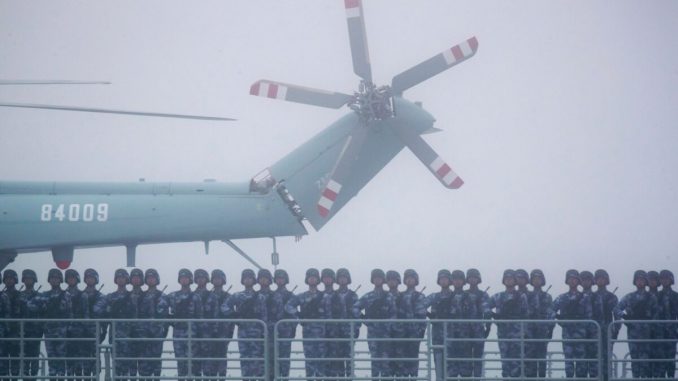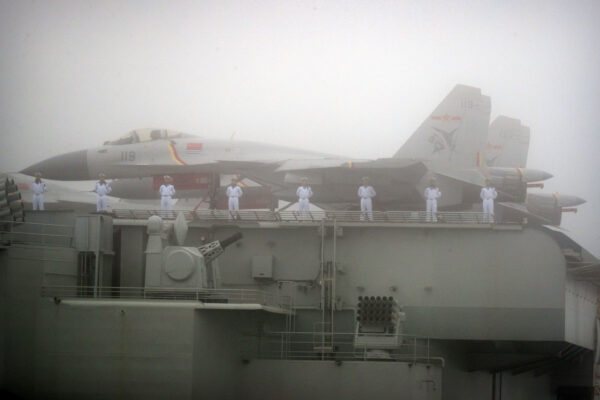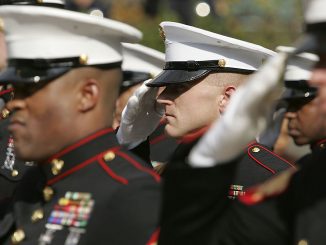
The Chinese regime recently unveiled three new warships to commemorate the 72nd anniversary of the founding of the Chinese Navy. The ships will be part of the regime’s South China Sea fleet. One Chinese media outlet claims that the move is meant to intimidate Taiwan, neighboring countries in the Indo-Pacific region, and the United States.
The three warships unveiled by Xi on April 23 are Changzheng-18, a Type 094A ballistic missile submarine; Dalian, a Type 055 destroyer; and Hainan, a Type 075 amphibious assault ship. Xi attended the commissioning ceremony, and personally presented the CCP’s military flag and naming certificates to the captains and political commissars of the new ships.
According to state-run media China Global Television Network (CGTN), the Changzheng-18 is capable of launching a “second-strike,” which means that it can respond to an attacker with powerful nuclear retaliation.
Dalian can act as a guardian ship to carriers like Liaoning and Shandong, while Hainan would be used to land on enemy territories—a mission similar to the well-known Normandy landings—and act as a command ship during such operations, CGTN reported.

Three New Warships Send a Strong Message
The CCP’s mouthpiece Global Times cites a high-profile commentary by a Chinese military expert as claiming that adding three new warships will greatly enhance the Chinese Navy’s ability to seize islands in the South China Sea, as well as its secondary nuclear counterattack capability.
Meanwhile, Beijing-based DWNews said that this move contains “significant political semiotics” that targets Taiwan, countries in the South China Sea region, and the United States. The warships serve as a warning.
The report said the CCP’s first warning is aimed at Taiwan: the Chinese military has the ability to seize the island, and the Dalian and Hainan ships can carry out this combat mission.
The second warning is meant for the neighboring countries in the South China Sea: the CCP has the ability to solve the disputes in the region by force.
The third warning is for the United States: Beijing can use the Changzheng-18 as a “powerful tool to defend the country” when its conventional weapons are not powerful enough, the report said.
On the same day when the three new ships were unveiled, state-run media Legal Daily published an article titled, “Reporting to the Party Flag from the Ocean.” It states that the goal of the CCP’s Navy is to “resolutely listen to the Party’s command, accelerate the transformation and development, build a first-class navy, and be ready for war at any moment.”
According to Su Ziyun, director at the Institute for National Defense and Security Research (INDSR) in Taiwan, the unveiling of the ships clearly indicates that the CCP’s naval strategy is “to be defensive in the North and offensive in the South,” Taiwan newspaper United Daily News (UDN) reported.
According to Su’s analysis, the CCP is constrained by Japan, South Korea, and Taiwan in the northern and eastern zones; while the South China Sea is a deep water zone, the region is conducive to the overall development and training of the CCP’s surface and underwater fleet, the report said.

Xi Rallies the Troops
After handing over the three warships to the South China Sea fleet on April 23, Xi Jinping visited the Red Army Long March Xiangjiang Battle Memorial Park in Guilin city, Guangxi Province on April 25, state-run media Xinhua reported.
Xi declared that the Xiangjiang battle was an “important historical event” that decided the fate of the CCP’s revolution, and called on the people to “persevere in the most difficult times” in order to achieve “miraculous victories,” according to the report.
He urged the Chinese troops to “think of the Long March of the Red Army and the bloody battle on the Xiangjiang River, even if the difficulties are great,” Xinhua wrote.
Soon after Xi gave his speech, Xinhua released a short video called “The Blood Stained Xiangjiang River” and published an article titled, “Why Xi Jinping Attaches So Much Importance to This Crucial Battle.” The article emphasized the heavy losses the CCP’s Red Army suffered during the battle, and encouraged the Chinese people to “love the Party” and “to love the country.”
The so-called “bloody battle of Xiangjiang” took place between late November and early December in 1934, and it was the first civil war between the CCP and the Kuomintang. The CCP’s Red Army lost nearly 70 percent of its troops. The number of its soldiers dropped from nearly 100,000 to 30,000. The Red Army was besieged by the Kuomintang army and was forced to flee to Southwest China.
The CCP has always claimed that this fleeing process was the “25,000-mile Long March” and called it “Going North to Fight the Japanese.” However, the battlefield where the Japanese troops were fought was not in the southwest, but in the northeast of China.
Provoking Japan, the US
On April 25, the same day that Xi gave a speech on the Xiangjiang battle, Xinhua published an article, claiming that a fleet of Chinese marine police vessels were cruising in the territorial waters of the Diaoyu Islands. In addition, Xinhua reposted an article from state-run media Reference News, titled, “Japanese Media: Chinese Ships Come Too When the U.S. Military Practices Airdrops Around the Diaoyu Islands.”
Citing an April 23 Nikkei report, Xinhua reported that while the U.S. military conducted drills near the Diaoyu Islands (known in Japan as the Senkaku Islands), Chinese maritime police vessels and fighter planes had approached from the sky and sea to provoke.
Xinhua rarely quotes Japanese media’s narrative about the Japan-U.S. Security Treaty, stating that Article 5 of the treaty stipulates that the United States is obliged to defend Japan should its territories come under attack, and that the Japanese and U.S. leaders have repeatedly confirmed that the waters of the Diaoyu Islands are also applicable to this provision.
The article also quoted Nikkei as saying that, “If Chinese forces land on the Diaoyu Islands and its affiliated islands, the U.S. forces will join the Self-Defense Forces [of Japan] in a counterattack to seize the islands.”
In response to Xinhua’s rare action of directly quoting a Japanese media outlet, U.S.-based China expert Li Yanming told the Epoch Times that the CCP is openly provoking the U.S.-Japan alliance.
“At this sensitive moment when the situation in the Taiwan Strait and the South China Sea is heating up, the CCP’s media deliberately quoted the Japanese media’s account of the Japan-U.S. Security Treaty. This is to openly provoke the U.S.-Japan alliance and to demonstrate the CCP’s ambition to gain global domination,” Li said.
“The CCP has already begun its full-scale military expansion. Not only did it [CCP] provoke Taiwan and other countries in the South China Sea and the East China Sea, but it also called out the United States, which is committed to maintaining peace in the Indo-Pacific region. The CCP is stirring up nationalistic sentiment at home, which has greatly increased the risk of military conflicts in the Indo-Pacific region,” Li emphasized.





Be the first to comment